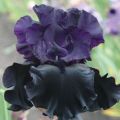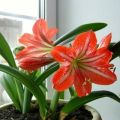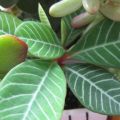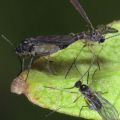Description of varieties of indoor gerbera, cultivation and care, diseases and pests
Indoor gerberas are like multi-colored daisies. It is the variety of color shades that makes them especially popular. Flowers are a stunning decoration at home and, with proper care, will delight you with an abundance of colors when blooming. These delicate plants need careful maintenance. Otherwise, immunity decreases, the risk of infection by fungal diseases or pests increases.
Gerbera varieties suitable for home growing
Specially bred dwarf varieties, supplied from Holland in special containers, are suitable for home breeding. Indoor gerberas are characterized by compact size, not exceeding 0.3 m in height. The following varieties of gerberas are adapted for cultivation at home:
- Gerdera Happipot - has pink petals with a multi-layered structure, matte color, the middle is brown, surrounded by the smallest pink petals.
- Gerbera Parade - flowers have orange and yellow shades, the middle has a similar color.
- Gerbera Ilios - has flowers of different sizes and colors, the range of colors ranges from soft tones: orange, yellow, light red.
- Gerbera Hummingbird - has inflorescences of bright scarlet, purple, yellow color shades.
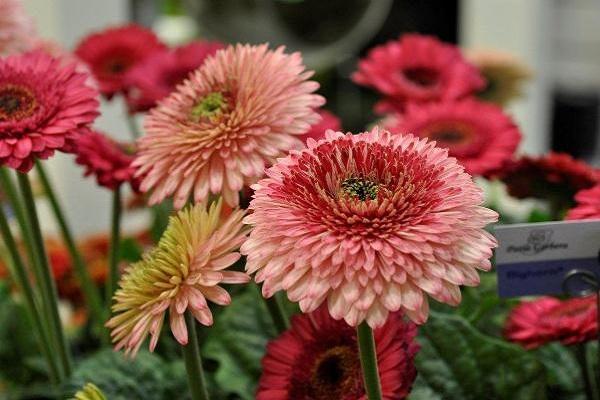
Growing features
An important condition for preventing gerbera from affecting room diseases and pests is compliance with the cultivation characteristics:
- steam the soil for the purpose of disinfection before transplanting;
- control the level of soil acidity;
- monitor the temperature regime;
- organize sufficient lighting;
- follow the rules of watering, avoid excessive moisture or dryness, which will cause the development of diseases.
In addition, the gerbera is rejuvenated every fourth year in a pot. Creating a cycle for the plant remains an important requirement. Flowering time is from August to October. Then the gerbera sleeps for four months. It is necessary to reduce the number and volume of irrigation, reduce lighting. At the end of winter, the growth phase begins actively. It is important to resume watering and feed the flower. If you do not follow the rules of cyclicality, the plant will bloom all year, which will lead to its depletion. Gerbera can die.
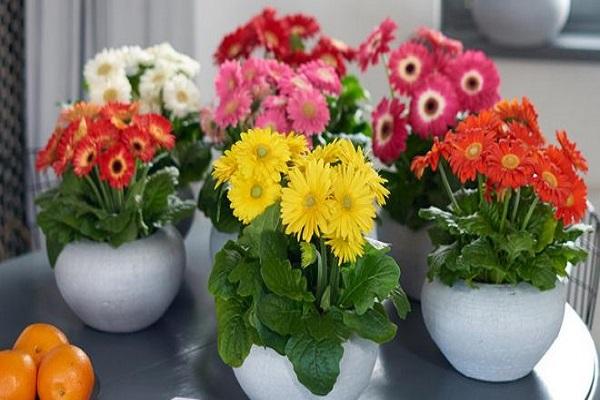
What should be done after purchase?
After buying in a specialized store, the flower needs to be transplanted. For this it is important to wait 2-3 weeks. The plant is difficult to adapt to changing climatic conditions.The transplant is postponed if the gerbera is in bloom.
Before the transplanting process, you must choose the right pot. It should exceed the previous one by only 20-30 mm. The pot should not be very deep and wide, otherwise the gerbera will stop blooming and start developing the root system. The ideal material for a container is clay.
It is recommended to choose a sunny place. Gerbera does not like drafts; it is not recommended to put it on the window that is used for ventilation. Although the plant is thermophilic, it does not tolerate extreme heat and direct sunlight. In the sun, it is undesirable to place the plant on a window on the south side.
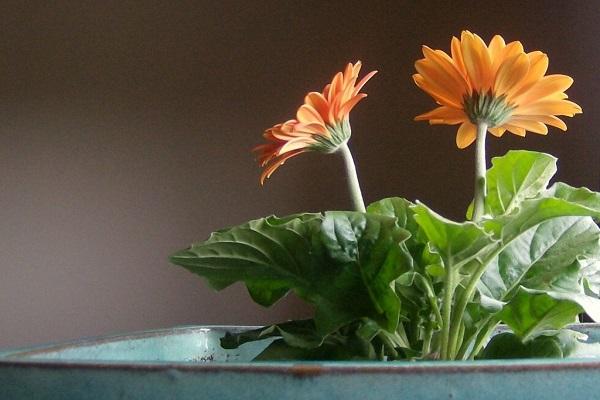
Houseplant care
The flower needs careful care, since it is its absence that will cause the gerbera to be damaged by diseases and pests.
Temperature and light conditions
The culture does not like temperature changes, if during the day the pot is taken out to the loggia or balcony, it must be brought in at night. Optimum temperature - from 20 to 25 aboutC. At the moment of rest, the required temperature is 12-15 aboutC. When the thermometer mark drops below 12 aboutThe flower dies.
Lighting regulation contributes to high-quality flowering. Although gerbera loves light, prolonged exposure to the sun will shorten the flowering period. In the summer, the duration of light wakefulness is 10-12 hours. An increased growth of the leaf part is observed, by the middle (end) of autumn the first buds will appear.
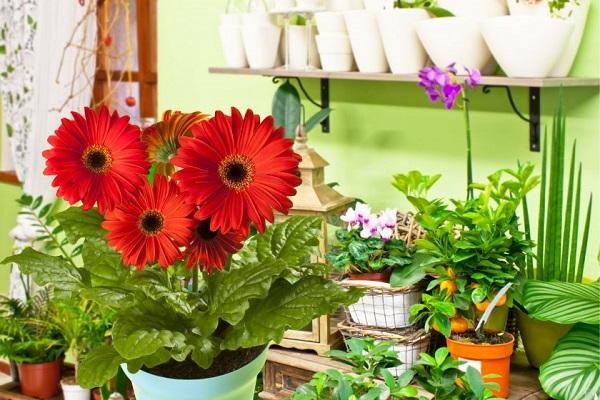
Watering rules
The natural habitat of the plant is the tropical zone. Accordingly, gerbera prefers humidity in the environment: air and earth. Optimally, watering is required twice a week. In winter, if the flower is near a heating device, and in summer, the amount of watering increases. The main rule: the ground should not become dry and should not be excessively moist..
During the watering process, it is important to ensure that no liquid gets onto the leaf outlet. This will cause the development of harmful organisms, molds. For irrigation, use exclusively thawed or settled warm water.
Air humidity
If the air is dry (in winter near the battery or in summer), it is necessary to irrigate the plant, but make sure that water does not fall on the inflorescence and the base of the leaf plates. It is recommended to put a container with wet pebbles next to the pot. Evaporation will provide a sufficient water balance for the flower.

Transplanting, soil and feeding
Gerbera is unpretentious, calmly tolerates transplantation. This procedure is carried out at the end of winter, when the plant is dormant. The most optimal method is transshipment with the root ball. You cannot prune the roots.
The soil needs a porous, light, air-permeable soil. It is recommended to use peat and perlite in equal parts for the substrate. The following mixture is also suitable: earth (2 parts), sand and peat (one part at a time). The acidity of the soil is taken into account - 6 pH. You cannot add compost or rotted organic matter, they will burn the root system.
It is necessary to feed the plant during the entire spring and summer period. For full growth, it is enough to apply a complex fertilizer twice a month. It is not recommended to use organics.
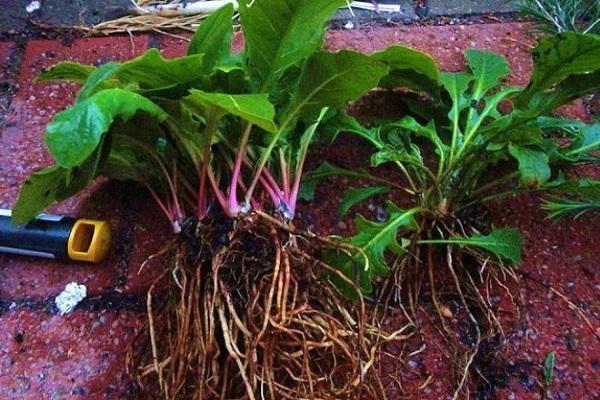
Protection against diseases and pests
This flower is susceptible to a variety of diseases, but the reason for them is, first of all, improper care.
If the plant turns yellow, throws off the foliage, there is an assumption of a spider mite lesion. These parasites develop in overdried soil, with insufficient moisture. As a preventive measure, it is recommended to irrigate the leaf plates and stems with cold water.
Gerbera is often affected by powdery mildew.The reason is the temperature difference, watering with cold liquid or an excess of fertilizers containing nitrogen.
If brown spots appear on the leaves, this indicates an Alternaria infection. They become lighter over time. If the flower is too moist, they become covered with a velvety bloom. Yellowed leaves also indicate the presence of the disease. Weak plants are most affected, with insufficient nutrition.

Flower propagation
Flower reproduction is carried out in several ways, each of which has its own characteristics. Considering this, the florist chooses a convenient and optimal way for himself.
Cuttings
The process requires a special temperature regime - 24 aboutC, and high humidity.
It is necessary:
- dig out the bush, rinse, cut off the leaf plate;
- plant the rhizome in a greenhouse;
- shoots will grow from the sinuses, they will become the basis of the cuttings;
- prepare cuttings from the strengthened sprouts: cut at the root with a knife, plant in loose soil, put a 2-centimeter layer of sand with perlite on top.

For successful rooting, it is necessary to maintain the container at a temperature of at least 24 aboutWith and high humidity. If the cuttings are treated with a growth stimulant, rooting will occur faster.
Planting seeds
To obtain a young plant, seeds are sown. It is recommended to purchase seed from a specialized store. Disembarkation is made in small containers. Cover the sowing with glass or foil. Air humidity must be increased for fast and efficient germination. Optimum temperature regime - 24 aboutC. After the sprouts appear, remove the glass or film.
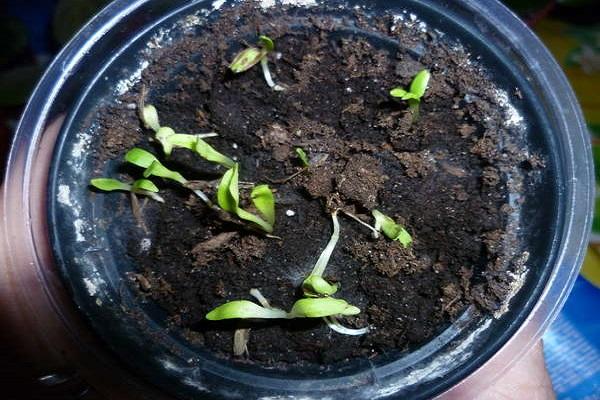
Dividing the bush
The home breeding method also involves dividing the shrub. Recognized as the most convenient. Produced in the summer. It is necessary:
- Remove the top layer of the earth. Expose the roots and make cuts, dividing the plant in two.
- Sprinkle the place of the cut with crushed coal.
- Watering is necessary along the edges of the pot.
- When new roots appear, carefully remove the flower from the pot, divide it into two parts, and plant it. Plants will bloom next year.

What mistakes to avoid
Sometimes, if the necessary requirements are met when growing, gerbera does not bloom. It is worth understanding why indoor gerbera does not produce flowers. One of the reasons is the large pot. The plant actively began to form the root system, from which the ground part suffers.
Excessive nutrition, non-observance of the temperature regime, stop flowering. Also, gerbera does not bloom, observing the usual cycle. In winter, the plant rests. Do not break your usual routine. Only with careful observance of the basic requirements for the care of a gerbera will please with an abundance of flowering.



